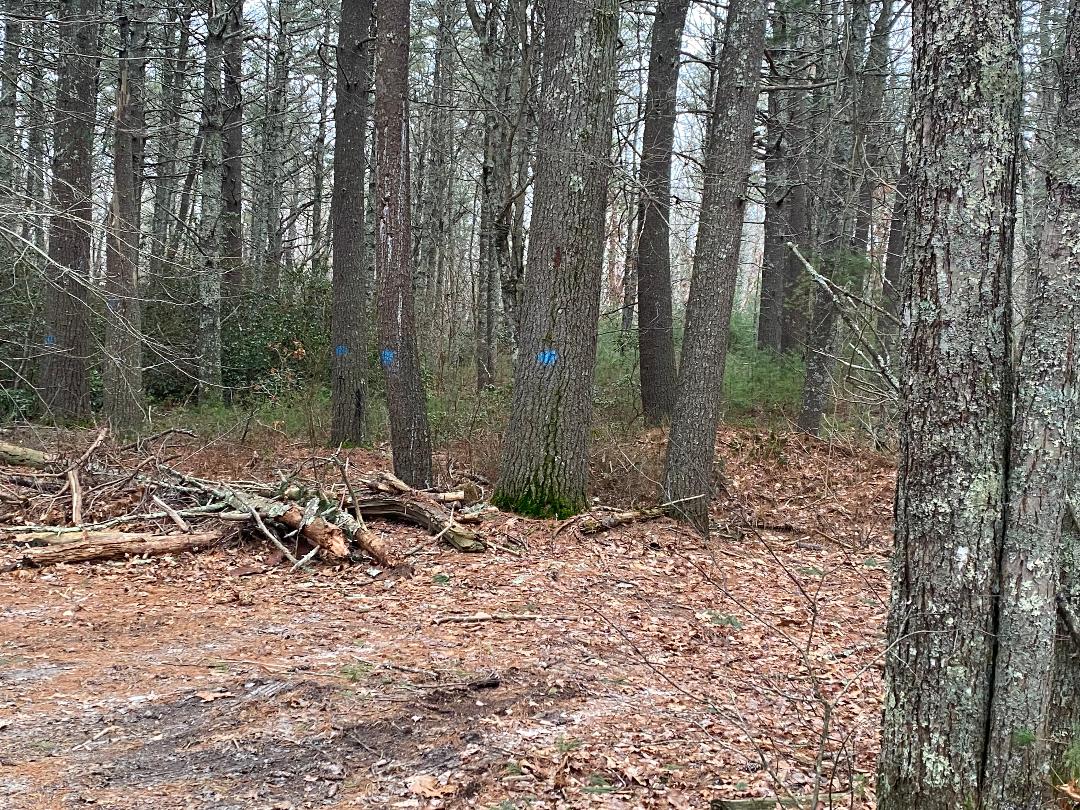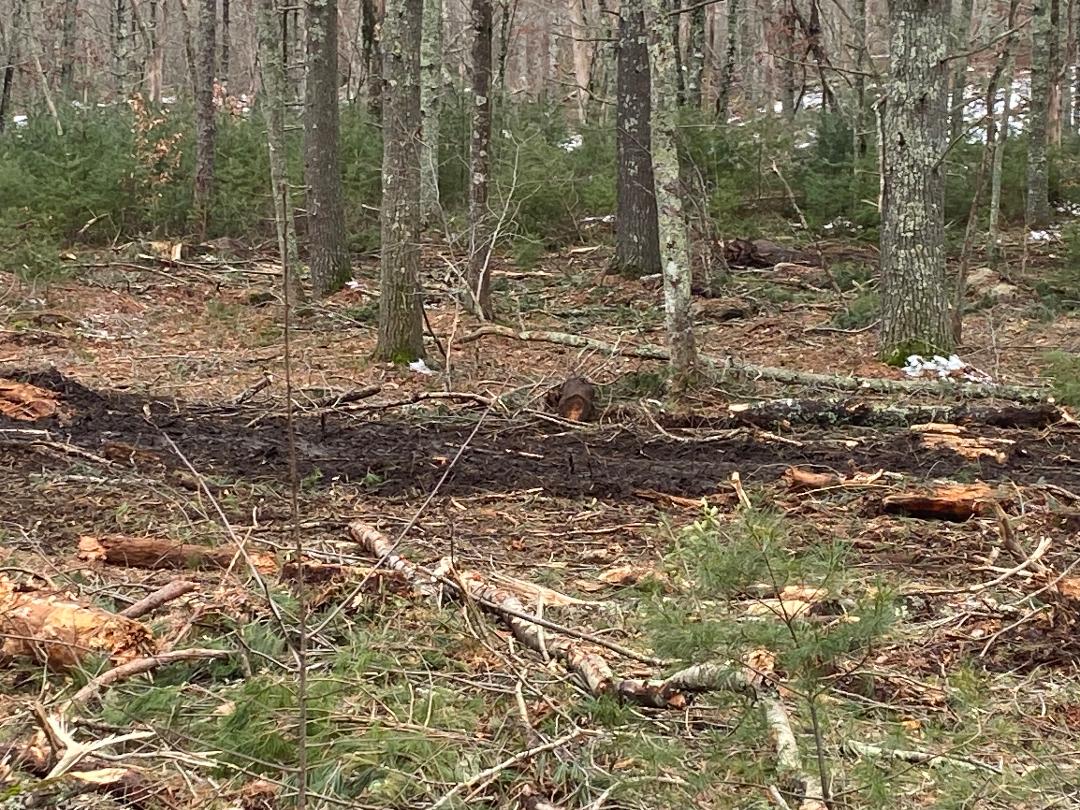Creation of Wildfire Suppression Fuel Breaks in Arcadia Raises Questions
Exeter resident concerned DEM’s forest thinning has gone too far
March 18, 2024
EXETER, R.I. — Along a section of Blitzkrieg Trail, a remote dirt fire road within the Arcadia Management Area, a number of trees have been cut down, thinning the forest and creating what is known as a “shaded fuel break.”
The state Department of Environmental Management says that thinning dense tree cover and removing underlying brush along Blitzkrieg Trail and in other parts of the 14,000-acre Arcadia Management Area will help lessen the risk of “a wildfire becoming an uncontrolled wildfire.”
But Blitzkrieg Trail resident Diana Kushner believes DEM went too far.
“I found this extra tree cutting upsetting because I couldn’t imagine it was necessary to meet the fire suppression goals of the project,” Kushner wrote in an email to ecoRI News. She said she is not against fuel breaks, but rather questioned the location of the one on Blitzkrieg Trail, which is across the road from a gravel pit.
The creation of fuel breaks is not without controversy, with some forest advocates calling them unnecessary and a form of clear-cutting, and others, including Kushner, questioning their effects on carbon sequestration.
“The trees in the forest belong to all of the people in the state. They are our commons, and among the many benefits they give to us is the gift of sequestering carbon,” Kushner said. “Older, larger trees are better at taking the carbon out of the atmosphere than younger trees.”
But balancing the necessity of reducing wildfire risk through fuel breaks with the climate importance of forest carbon sequestration is tricky.
“This is a complicated conversation,” said Tee Jay Boudreau, a deputy chief in DEM’s Division of Agriculture and Forest Environment. “What we’re doing is not unique. We’re following best management practices from the National Cohesive Wildfire Strategy, which is followed throughout the country. It’s just new to Rhode Island. And it looks like we’re doing something that goes against what’s in people’s guts.”
A fuel break is designed to reduce and manage fire fuel within a designated area. By thinning trees, underbrush, and shrubs and removing downed and dead branches, foresters are reducing fuel for a fire, thus limiting a fire’s speed and severity.
Boudreau noted that creating gaps in the tree canopy in the area of a shaded fuel break slows the spread of a fire that jumps from canopy to canopy, as happened last April in the Queen’s River fire in Exeter, which was the state’s worst fire in decades, burning 286 acres.
“The work that we’re doing at the state level is work that’s being done to create a healthier, more resilient forest, in light of climate change and all of the things affecting our forests in a negative way,” Boudreau said.
Climate change has resulted in a dryer growing season, with forests becoming less healthy and more susceptible to damage from pests and diseases, which in turn creates scenario where the forest is more vulnerable to fire, he added.
As far as fuel breaks’ effects on carbon sequestration, Boudreau said there are several ways to look at the issue. Although the removal of a tree eliminates that tree’s ability to sequester carbon, the material that is processed from that wood, which gets sent to a local mill, in turn gets made into a product that stays local.
“That saves carbon, because that material isn’t getting shipped from outside New England,” he said.

“Nothing we do is a for-profit business,” Boudreau said. “Our work is directed toward creating a healthy forest, creating an atmosphere that creates an ecosystem that allows trees to become healthier and therefore able to better sequester carbon.
“Us in forestry have degrees in higher education. We’re not doing this in a vacuum. We’re not just going out and saying it’s time we cut down trees to be safe from fire.”
On a walk down Blitzkrieg Trail with a reporter in early February, Kushner pointed out a number of trees that were marked with blue paint by the DEM, signaling they were to be cut down.
Some of the marked trees were young saplings, but others were bigger. All the trees marked for cutting were on the south side of the road. On the north side there was a small strip of forest containing mostly small shrubs and bittersweet plants, and a large gravel pit.
On a return visit in March, the forest on the south side of the road had changed, with many trees gone and a slash of dark-brown bare earth visible.
Boudreau said the state is creating “the bare minimum” of a fuel break, trimming only 66 feet into the forest.
As part of the Arcadia fuel break project, the DEM Forest Fire Program mapped out priority fire roads within the management area and planned the breaks to work in conjunction with the fire roads, to act somewhat like a firebreak. This will “strengthen firefighters’ ability to reduce a fire’s speed and severity,” according to DEM.
“Implementing this strategy involves some cutting, but leaves behind many mature, well-spaced, healthy trees with carbon sequestration value. It is not clear-cutting,” DEM officials said.
A September 2023 article in Forest Ecology and Management said fuel breaks “clearly change wildfire behavior by reducing the intensity of the flames, thus reducing the level of burn severity and preserving vegetation health.”
According to the article, after a fire, “the fuel break region contained trees that were still intact with green crown canopies, whereas the surrounding untreated region was severely damaged with no preservation of tree canopies, leaving only the stumps and bare trunks.”

According to a 2022 article published by the World Resources Institute, a Washington, D.C.-based nonprofit focused on sustainability, “More research is needed to accurately quantify the short-term (5-10 year) and long-term (10-50 year) carbon impacts of these treatments in different ecosystems. But many studies indicate that while there is an initial loss of carbon, ecologically informed fuel load treatments may protect the carbon stored in forests in the long-term. This only holds true, however, when healthy, large-diameter trees are not harvested in the process of fuel load treatment. These treatments also may help to decrease the rising cost of suppressing wildfires once they have started.”
The focus on fighting wildfires in Rhode Island comes after a busy wildfire season in 2023, with 78 wildfires burning 582 acres in the state.
The General Assembly empaneled a study commission in September to analyze the state’s response and existing policies regarding wildfires, with an eye on preventing the next one.
The commission has yet to issue a final report, but its recommendations included mapping all fire roads in forestland around the state; improving outreach to landowners of forested properties to help them craft fire mitigation plans; and developing a statewide wildfire contingency plan with resources and contacts.
Rep. Megan Cotter, D-Exeter, who chaired the study commission, has also introduced two bills to boost forestry management in the state. The first (H7258) would allocate 10 full-time equivalent (FTE) positions within DEM’s forestry division. Cotter said she would like to see more people in the department performing outreach to large, forested landowners, but also more rangers to enable DEM to have a greater presence on state property.
“There’s so many roles to fill, 10 FTEs is barely scratching the surface,” Cotter said.
In 1990, DEM’s forestry division employed 18 laborers, 16 rangers, seven foresters, and two equipment operators. There are now three laborers, four rangers, six foresters, and no equipment operators.
Cotter’s other bill (H7550) would add $16 million to the proposed green economy bond, including $3 million set aside for forestry management purposes.
The $360,000 fire break project in Arcadia is funded by the 2022 green bond.




DEM should work with the indigenous community to form a forest management plan that works for Rhode Island. This is now a practice with the National Park Service and Forest Service out west as was documented in Sierra Magazine article regarding controlled burns.
The result of cutting may not appear attractive, but the effects of a wildfire are dramatic. Perhaps a photo of the burned areas from last summer would have been helpful for comparison in the article. No one wants the burned out homes and devastating losses as has been the case out west. Firebreaks are a good tool in preventing these losses. In the south, they are common practice.
I’ll bet that DEM Forestry didn’t consult with DEM Fish and Wildlife on the effects of these practices on the non-game wildlife species. If they did, then Fish and Wildlife dropped the ball.
So if someone in this “indigenous community” has expertise in crafting forest management plans they should speak up. Or maybe this is just politically correct woke nonsense.
It brakes my heart to see perfectly health trees marked for destruction. There is clear cutting every where you turn. When is enough enough ?